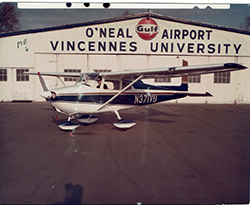Aviation Trailblazer Frank O'Neal - VU Alumni Foundation Site
Award Named After Aviation Trailblazer Frank O'Neal

The Vincennes University Aviation program has announced a new award for an outstanding first-year aviation flight or maintenance student. The first Frank O'Neal Aviation Trailblazer Award will be presented in Spring 2022 and include a scholarship award. Guest Contributor and VU alumnus David Goodnow (VU '59) shares the history of pioneer Frank O'Neal.
THE FRANK J. O’NEAL AVIATION TRAILBLAZER AWARD
by
David Goodnow
The Frank J. O’Neal Award salutes a record of accomplishment by a Vincennes University student as a prelude to a lifetime of service. This honor commemorates the pioneering Indiana pilot and educator who helped make aviation a reality for many young fliers beginning in the 1930’s. His foresight and energies were important to the realization of an aviation division that would one day be developed by Vincennes University.
The world of aviation has had many pioneers, those scientists and dreamers who knew there was a way to fly and fly well, thus making their names come down to us through the annals of aviation's accomplishments. Some would fit the true definition of “Trailblazer,” pioneers in the science and art of flying.
Recalling the name Frank O’Neal will make several generations of pilots fondly remember the soft spoken man who helped make aviation grow and develop, not only in the Midwest but also in our national defense.
The Vincennes University Aviation Division at O’Neal Airport became a reality in the 1960’s building upon Frank’s accomplishments and experience. He was a veteran aviator by the time V.U. was ready to launch into its various flight programs. As a barnstormer, parachutist and wing-walker, performing before many crowds in the early years of aviation, O’Neal had a vision to help build interests in flying whenever and wherever possible. Along the way he saw aviation develop from the time it was looked upon with all the seriousness of a vaudeville act until it has become one of our nation’s great industries.
Frank O’Neal began his lifelong romance with the sky by building a real airplane from a kit made by the Heath Company in 1919. While other young men might have been building model planes, Frank had built the real thing but was still not a pilot. He took flying lessons from instructor and veteran World War One pilot Joe Walker in Oakland City in 1920. With less than three hours of instruction, O’Neal was flying solo and beginning his career in the air.
Wanting a substantial aircraft, Frank and a friend named Ogle Weeks took the Dixie Beeline to Georgia in 1922 shopping for some war surplus airplanes. Souther Field at Americus, Georgia, had been a wartime aviation training center, but was now deactivated and planes were available at bargain prices to anyone with the cash and the means to take them away. Frank had both, and his dreams of flight were continuing to unfold.
The Georgia trip took place about the same time Charles Lindbergh also went to Americus to buy his first plane. Lindbergh would later be known as the famed Lone Eagle, the first to fly solo across the Atlantic Ocean. Thus, Frank O’Neal and Charles Lindbergh had a connection, of sorts, in early flight.
Paying around $500 each for several Curtiss “Jennies,” the JN-4 biplanes, Frank and his friend Ogle Weeks disassembled them and hauled them north to Indiana where barnstorming and other aerial feats were soon to be part of the air show O’Neal would present to an amazed public. In assembling the planes, he would also repair damages early military student pilots had inflicted on the machines during the war.
A tract of land came up for sale on South Sixth Street Road in 1923. Frank, the entrepreneur, bought it and it soon became home to the Sho Me Flying Circus which would feature Frank, the daredevil, doing wing walking stunts, parachute jumps and aerobatics. In between all these air shows, Frank, the engineer, continued rebuilding planes and their engines, gaining a more thorough knowledge of aircraft.
In 1926, Frank had his eye on a parcel of land across the Wabash River from Vincennes. The Illinois location was soon to be the site of the two-plane wooden hanger that was moved from its South 6th Street location. By this time, his operation had become a full-fledged airport and required his management skills, which were considerable.
By 1929, an air mail service was established between Louisville, Kentucky and Cleveland, Ohio. There was Frank O’Neal again, the pilot, flying many different types of early state-of-the-art aircraft. The mail route was established by Universal Airlines which would later become American Airlines.
In that busy year, Frank’s first big hanger went up at the O’Neal Airport as he continued training pilots and rebuilding aircraft. Many early students went on to find important positions in the field of aviation.
World War Two brought with it a need for new pilots. Uncle Sam had already established the Civilian Pilot Training program. Frank knew the need for aviators would be great and by the time the U.S. was involved in the war in 1941, he had bought the Hilliard Flying School in Evansville, Indiana. He operated it in conjunction with Evansville College teaching primary and advanced flight training. The O’Neal operation there totaled 20 aircraft and 15 full-time instructors. Frank sold the school in 1943 concentrating his efforts on the original airport bearing his name.
By war’s end, it was time to expand so the O’Neal Aviation Corporation was founded in 1946 with friends Earl Leach and Jim Beamon, both World War Two decorated combat pilots. The three men operated the pilot training program for veterans as long as it was available. A large sign greeted airport visitors letting them know “G.I.’s Fly Free.” Frank and his partners were giving back to any returning veterans who wanted to learn to fly.
By 1965, the O’Neal operation was a long established airport for flying of all sorts. It was then that Vincennes University began branching out again, building on Frank’s leadership and assuming operation of the airport to include aviation in the future of students who knew the sky was not the limit in their dreams. Frank O’Neal would smile when asked how all this came to be: young pilots in training, student mechanics learning their art, an art that has become ever more important as aviation has grown. O’Neal’s reply would be no surprise. He knew flying and everything associated with it would grow in demand as the years would unfold. He’d had an important hand in teaching fliers over many years and now its was time to be part of the continually growing Vincennes University as it looked ahead. As part of his commitment to the V.U. Aviation Division, Frank presented his personal Bonanza airplane to V.U. This would be the first aircraft in which students would receive instruction in retractable landing gear operation, moving along through their primary training phase.
Today, the Aviation Technology Center of Vincennes University in Indianapolis is a location for comprehensive programs that bring state-of-the-art equipment and excellent instruction to bear in the classroom and in the cockpit. It is a testament to the foresight of such aviation pioneers as Frank O’Neal. His trademark grin would be evident if he could tour the great aviation facility that has grown out of his imagination those many years ago.
Frank J. O’Neal, entrepreneur, pioneering aviator and educator.
